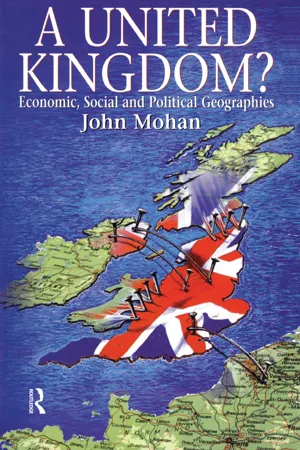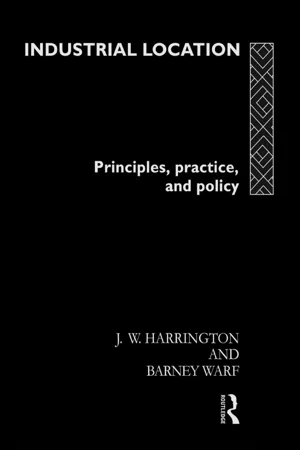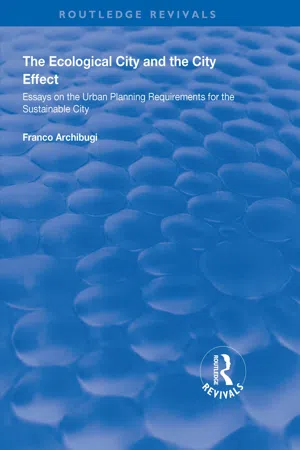Geography
Deindustrialisation
Deindustrialisation refers to the decline of industrial activity in a region or country. This can occur due to a variety of factors such as technological advancements, globalisation, and changes in consumer demand. The process can have significant impacts on employment, economic growth, and social structures.
Written by Perlego with AI-assistance
Related key terms
Related key terms
1 of 4
Related key terms
1 of 3
4 Key excerpts on "Deindustrialisation"
- eBook - ePub
A United Kingdom?
Economic, Social and Political Geographies
- John Mohan(Author)
- 2014(Publication Date)
- Routledge(Publisher)
The focus of the chapter is on the absolute and relative decline of manufacturing, but this decline has of course prompted efforts to modernise manufacturing. It is worth considering whether the measures taken to achieve this were the only ones available, whether they were inevitable or not, and whether they have succeeded. This raises numerous questions about the social and economic costs and benefits of economic change (Turner, 1995a). The chapter begins by briefly putting Deindustrialisation, and the explanations for it, in context. Key dimensions of Deindustrialisation are then discussed: the geography of recession, in the early 1980s and 1990s; the impacts of nationalised industry policies and of privatisation; and the urban–rural shift. There follows a discussion of new forms of production organisation within manufacturing, concentrating on the impacts of foreign direct investment and assessing whether contemporary changes indeed signify a novel departure or whether they merely represent efforts to preserve old modes of accumulation. Throughout, attention is paid to the contrasting methodological standpoints of the authors whose work is reviewed.4.2 DEINDUSTRIALISATION IN CONTEXTSince at least the 1960s there has been a steady decline in the relative and absolute contribution to the British economy of manufacturing, regardless of whether this is measured in terms of output, investment, exports or employment. However, the weak performance of the industrial economy has been a source of concern for over 100 years. In this sense Deindustrialisation is simply a new name for an old problem (Martin and Rowthorn, 1986).The post-war ‘long boom’ to some extent shielded the UK from the regional industrial problems of the inter-war years, and helped disguise the poor competitive performance of manufacturing. However, even before that boom ended in the 1970s, Deindustrialisation was already under way. Key dimensions of this include: a cessation of productivity growth; a decline in output; a trade deficit in manufactured goods from 1983; declining profitability; and reductions in employment. Manufacturing employment peaked at 8.7 million in 1966; it is now around 4 million. In terms of relative shares, industry (manufacturing; energy and water supply; construction) accounted for 48 per cent of British civilian employment in 1955, which made the UK one of the most highly industrialised states in history (Hall, 1991); by contrast, by 1996 that share was approximately 23 per cent and today there are now more than two service sector employees for every worker in industry. Only in the West and East Midlands does industry’s share of employment exceed 30 per cent, but the figure for London is 11.6 per cent, while manufacturing alone now accounts for under 10 per cent of employment in London and Surrey. Only in Derbyshire, Leicestershire and Mid-Glamorgan are over 30 per cent of the workforce now in manufacturing (Figure 4.1 - eBook - ePub
- Latika Chaudhary, Bishnupriya Gupta, Tirthankar Roy, Anand V. Swamy, Latika Chaudhary, Bishnupriya Gupta, Tirthankar Roy, Anand V. Swamy(Authors)
- 2015(Publication Date)
- Routledge(Publisher)
Clingingsmith and Williamson (2008 , p. 210), however, define the term on the basis of the employment criterion in their framework of a two-good, three-input model. Assuming an immobile input of land in agriculture and of capital in manufacturing, along with a free mobility of labour across them, they define Deindustrialisation as a state of affairs where there is an exodus of labour from the manufacturing sector to agriculture. The exodus of labour can either be measured in the absolute numbers (strict Deindustrialisation) or as a share of total employment (weak Deindustrialisation).Focusing more on the political antecedent of the term, Roy (2000 , pp. 1142–1147) calls Deindustrialisation a theory that is constituted of four propositions: (i) traditional industries declined in a colony, (ii) the decline was initiated by technological obsolescence in the domestic economy, (iii) it was sustained by colonial policies, and (iv) the development of modern industries could not compensate for the economic loss resulting from the decline of traditional industries. This definition poses some problems for empirical application as it does not deal with (a) colonial industry that was not traditional, (b) the decline not being triggered by technological obsolescence but by discriminatory colonial policies, and (c) the decline caused by technological obsolescence but not sustained by discriminatory policies. These alternative events did occur in nineteenth-century India. For example, the shipbuilding industry, which had been developing in Bengal on the basis of European technology since 1780, was destroyed during the colonial period (case a); the decline of the salt industry in Bengal was not initiated by any technological obsolescence (case b); and the decline of the cotton textile industry in Bengal since the mid-1820s was not sustained by any discriminatory colonial policies of Great Britain (case c) (Ray 2011 - eBook - ePub
Industrial Location
Principles, Practice and Policy
- James W. Harrington, Barney Warf(Authors)
- 2002(Publication Date)
- Routledge(Publisher)
A popular, but erroneous, interpretation of deindustrialization is that it is a result of the growth of services. It is true that in the post-World War II era, when employment in manufacturing in many western nations began to decline, employment in services grew significantly. However, there is no convincing logic to the position that the growth of services is responsible for deindustrialization. The rising demand for services, however, does not explain the declining demand for manufactured products. Why, for example, should the increase in employment in a law firm or hospital lead to a decline in employment in a steel mill or rubber factory? If anything, because services consume some manufactured goods, the growth of services should increase employment in industry. Indeed, the loss of manufacturing has decreased employment in many services, particularly those “tied” to industry (e.g., shipping). Geographically, the highly uneven pattern of employment growth of services and manufacturing reflects relatively few connections between these two sectors. In some places, such as Pittsburgh or London, the decline in the steel industry was replaced by a growth of business services; in others, such as Detroit or Manchester, U.K., the decline in automobile production was not compensated by the growth of services, leading to steady decline. In cities such as Los Angeles or Tokyo, both services and manufacturing increased in employment simultaneously in the 1970s, creating a booming local economy.Figure 7.7 Location of U.S. manufacturing employment, 1960Figure 7.8 Location of U.S. manufacturing employment, 1970Figure 7.9 Location of U.S. manufacturing employment, 1980Figure 7.10Location of U.S. manufacturing employment, 1990It is important to note that the deindustrialization occurred differentially in terms of output and employment. In terms of output, manufacturing has remained roughly 22 percent of the GNP of western nations since the 1950s. In terms of employment, however, manufacturing has accounted for a steadily decreasing share of total employment; in the U.S., it dropped from roughly 45 percent of total jobs in 1950 to about 18 percent by 1990. The fact that western manufacturing firms can generate a constant or even rising output with fewer workers is a reflection of rising rates of industrial productivity.The Geographies of Deindustrialization
Like all economic processes, deindustrialization occurs unevenly over space. It is useful to interpret the geography of deindustrialization at three distinct spatial scales. First, at the intra-metropolitan scale, - eBook - ePub
The Ecological City and the City Effect
Essays on the Urban Planning Requirements for the Sustainable City
- Franco Archibugi(Author)
- 2019(Publication Date)
- Routledge(Publisher)
As such, it seems that urbanisation is remarkably contemporary to a primary stage of ‘industrialisation’, which has seen everywhere residents and jobs concentrated in already existing urban areas. This still occurs in all countries which are still in a more or less rapid industrialisation process in both Asia and Latin America (countries with urban histories considerably different from those of European cities).It also seems that the stage of sub-urbanisation corresponds very well to a further stage of industrialisation, that of ‘advanced’ or ‘excessive’ industrialisation, in which the per capita product increases, and there develops a greater demand for more spacious and comfortable housing (perhaps with a private garden).It seems, finally, that the stage of de-urbanisation corresponds well to the stage succeeding advanced industrialisation, that of de-industrialisation, that is of the absolute reduction of jobs in industry, and of growth, on the contrary, of tertiary activities; a stage, besides, in which the public infrastructure network of every type tends to cover the whole national territory, and the areas that were initially of a high urban density lose their ‘comparative economic advantages’. This is also the stage defined by many as the ‘post-industrial’ or information’ society.And finally the re-urbanisation stage, which, in its early days, seems in fact to be a phenomenon which has only appeared on the scene of the cities of the economically richer countries.It seems therefore that we can conclude that the degradation of the EU is to be linked to the advance of economic development rather than to different urban patterns and structures. And that these patterns and structures - in their current stage of development - are nothing more than a spontaneous and disorganised response to the imbalance that such a development provokes in the use of urban spaces.
Index pages curate the most relevant extracts from our library of academic textbooks. They’ve been created using an in-house natural language model (NLM), each adding context and meaning to key research topics.
Explore more topic indexes
Explore more topic indexes
1 of 6
Explore more topic indexes
1 of 4



